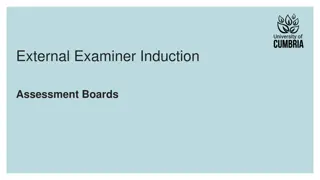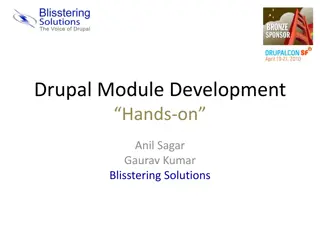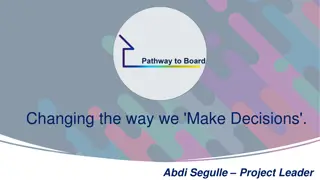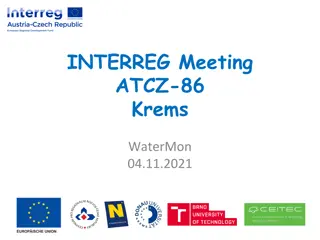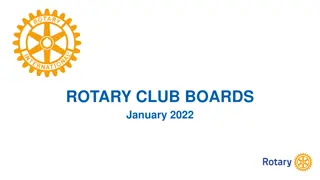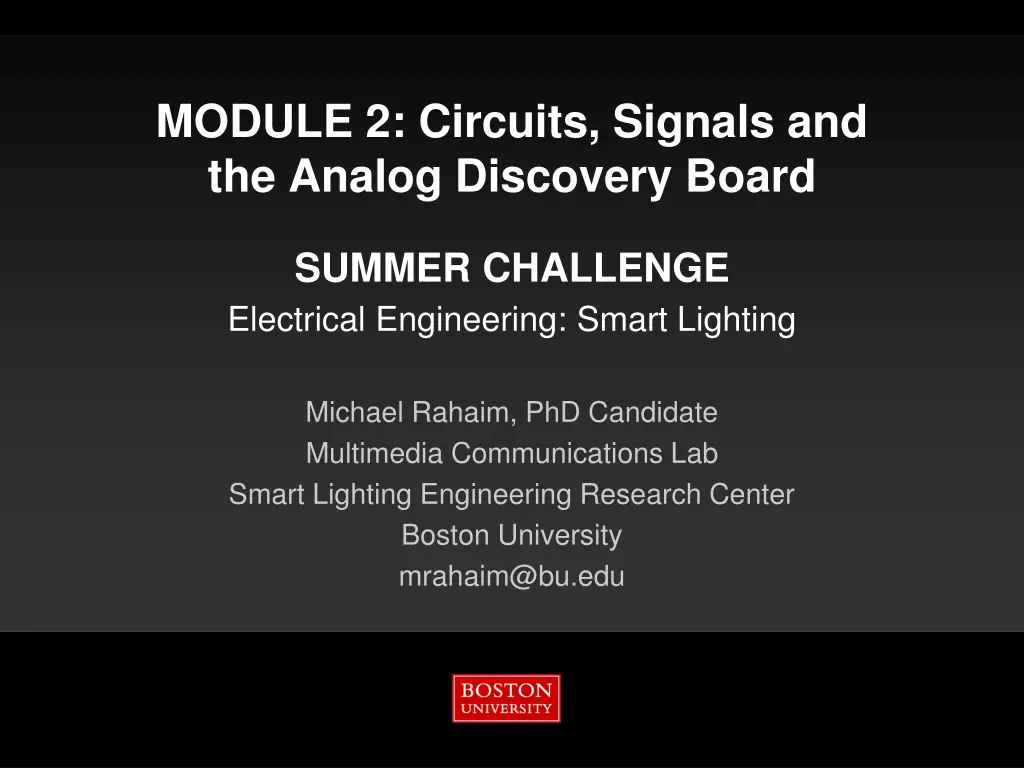
Smart Lighting Engineering Research at Boston University
Explore Module 2 on Circuits, Signals, and the Analog Discovery Board in the field of Smart Lighting Engineering. Delve into signal analysis, generation, observation, and experimentations with the AD Board to enhance your knowledge in electrical engineering. Join Michael Rahaim, a PhD Candidate from Boston University, on this educational journey.
Download Presentation

Please find below an Image/Link to download the presentation.
The content on the website is provided AS IS for your information and personal use only. It may not be sold, licensed, or shared on other websites without obtaining consent from the author. If you encounter any issues during the download, it is possible that the publisher has removed the file from their server.
You are allowed to download the files provided on this website for personal or commercial use, subject to the condition that they are used lawfully. All files are the property of their respective owners.
The content on the website is provided AS IS for your information and personal use only. It may not be sold, licensed, or shared on other websites without obtaining consent from the author.
E N D
Presentation Transcript
MODULE 2: Circuits, Signals and the Analog Discovery Board SUMMER CHALLENGE Electrical Engineering: Smart Lighting Michael Rahaim, PhD Candidate Multimedia Communications Lab Smart Lighting Engineering Research Center Boston University mrahaim@bu.edu
Module 2: Signals / The AD Board 07/07/2015 Signal Analysis - Recap Draw 3 more periods of the square wave Boston University Slideshow Title Goes Here What is the frequency of this waveform? Label the amplitude Label the pulse width What is the duty cycle of this square wave? Draw another signal with 25% duty cycle Draw another signal with a phase shift period Amplitude (Pk to Pk) t 1s Pulse Width Phase Shift 2
Module 2: Signals / The AD Board 07/07/2015 Signal Generation Boston University Slideshow Title Goes Here Function Generator Channel Select Amplitude here is the maximum deviation from zero Run/Stop Waveform Select Setting Sliders Signal Preview 3
Module 2: Signals / The AD Board 07/07/2015 Signal Observation Boston University Slideshow Title Goes Here Oscilloscope Measure Base Run/Stop Trigger Settings Range Received Signal View 4
Module 2: Signals / The AD Board 07/07/2015 AD Board Pinout 1+/- 2+/- V+/- W1 W2 T1 T2 0-15 Analog Input 1 (Oscilloscope and Voltmeter) Analog Input 2 (Oscilloscope and Voltmeter) Ground 5V DC Supply Analog Output 1 (Waveform Generator) Analog Output 2 (Waveform Generator) Trigger 1 Trigger 2 Digital Input and Output Boston University Slideshow Title Goes Here 5
Module 2: Signals / The AD Board 07/07/2015 Experiment II WaveForms Signal Generation Boston University Slideshow Title Goes Here Function Generator (i.e., waveform generator) Oscilloscope NOTE Connect the output of one analog discovery to the input of another 6
Module 2: Signals / The AD Board 07/07/2015 Analog Signals Boston University Slideshow Title Goes Here 2? radians = 360 ? ? = ? sin 2??? + ? ? = 2?? 7
Module 2: Signals / The AD Board 07/07/2015 Analog Signals Example: Sine Wave ? ? = ? sin ?? + ? Boston University Slideshow Title Goes Here 8
Module 2: Signals / The AD Board 07/07/2015 Frequency Domain Analysis Sine waves generate a pure frequency Boston University Slideshow Title Goes Here Time domain signals have a frequency domain representation and can be generated with a combination of sine waves Harmonics are integer multiples of a signals fundamental frequency 9
Module 2: Signals / The AD Board 07/07/2015 Experiment III Arbitrary Waveform Generator (AWG) Boston University Slideshow Title Goes Here Standard signals are a subset of potential AWG signals! Spectrum Analyzer 10
Module 2: Signals / The AD Board 07/07/2015 Recap References: Boston University Slideshow Title Goes Here http://www.physicsclassroom.com/ http://www.allaboutcircuits.com/ What did you today? 11











